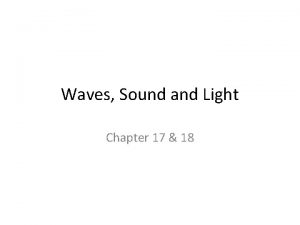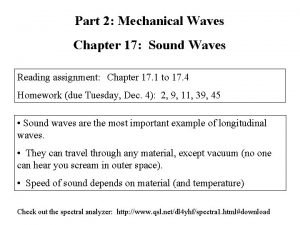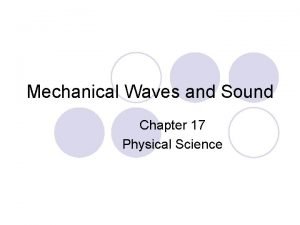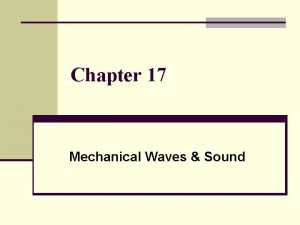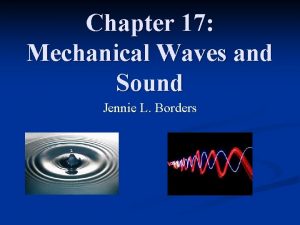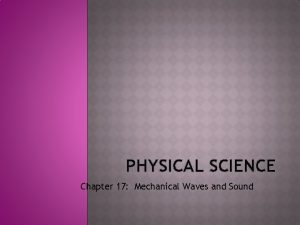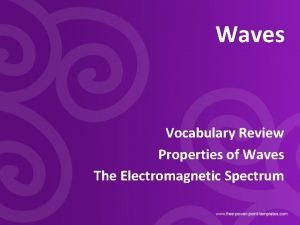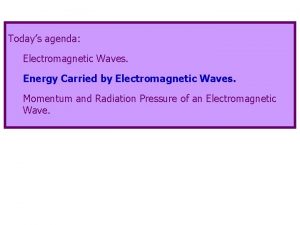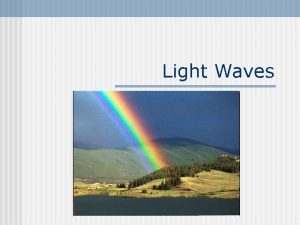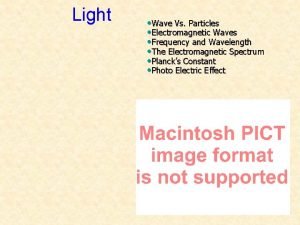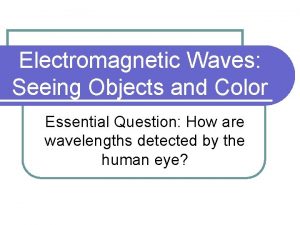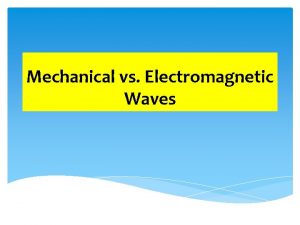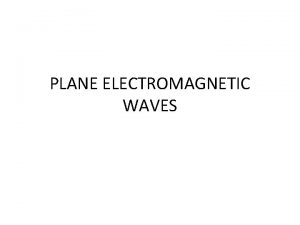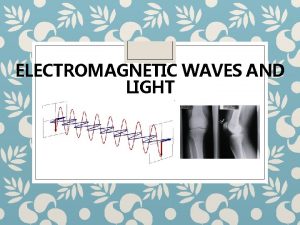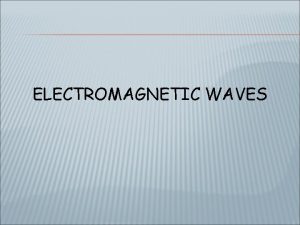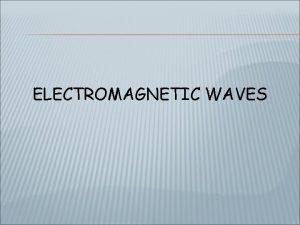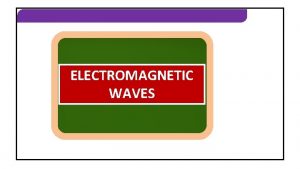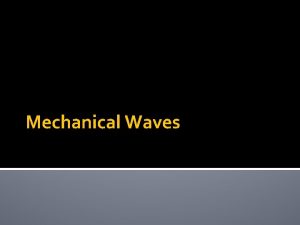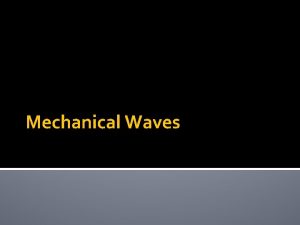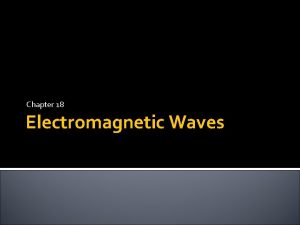Chapter 34 Electromagnetic Waves Electromagnetic Waves Mechanical waves




















- Slides: 20

Chapter 34 Electromagnetic Waves

Electromagnetic Waves Mechanical waves require the presence of a medium. Electromagnetic waves can propagate through empty space. Maxwell’s equations form theoretical basis of all electromagnetic waves that propagate through space at the speed of light. Hertz confirmed Maxwell’s prediction when he generated and detected electromagnetic waves in 1887. Electromagnetic waves are generated by oscillating electric charges. § The waves radiated from the oscillating charges can be detected at great distances. Electromagnetic waves carry energy and momentum. Electromagnetic waves cover many frequencies. Introduction

Maxwell’s Equations In his unified theory of electromagnetism, Maxwell showed that electromagnetic waves are a natural consequence of the fundamental laws expressed in these four equations: Section 34. 2

Speed of Electromagnetic Waves In empty space, q = 0 and I = 0 The last two equations can be solved to show that the speed at which electromagnetic waves travel is the speed of light. This result led Maxwell to predict that light waves were a form of electromagnetic radiation. Section 34. 2

Plane Electromagnetic Waves, cont. Waves in which the electric and magnetic fields are restricted to being parallel to a pair of perpendicular axes are said to be linearly polarized waves. We also assume that at any point in space, the magnitudes E and B of the fields depend upon x and t only. Section 34. 3

Rays A ray is a line along which the wave travels. All the rays for the type of linearly polarized waves that have been discussed are parallel. The collection of waves is called a plane wave. A surface connecting points of equal phase on all waves, called the wave front, is a geometric plane. A surface connecting points of radiation sends waves out radially in all directions. § A surface connecting points of equal phase for this situation is a sphere. § This wave is called a spherical wave. Section 34. 3

Properties of em Waves The solutions of Maxwell’s third and fourth equations are wave-like, with both E and B satisfying a wave equation. Electromagnetic waves travel at the speed of light: § This comes from the solution of Maxwell’s equations. Section 34. 3

Properties of em Waves, 2 The components of the electric and magnetic fields of plane electromagnetic waves are perpendicular to each other and perpendicular to the direction of propagation. § This can be summarized by saying that electromagnetic waves are transverse waves. The figure represents a sinusoidal em wave moving in the x direction with a speed c. Section 34. 3

Properties of em Waves, 3 The magnitudes of the electric and magnetic fields in empty space are related by the expression: § This comes from the solution of the partial differentials obtained from Maxwell’s equations. Electromagnetic waves obey the superposition principle. Section 34. 3

Production of em Waves by an Antenna Neither stationary charges nor steady currents can produce electromagnetic waves. The fundamental mechanism responsible for this radiation is the acceleration of a charged particle. Whenever a charged particle accelerates, it radiates energy. Section 34. 6

Production of em Waves by an Antenna, 2 This is a half-wave antenna. Two conducting rods are connected to a source of alternating voltage. The length of each rod is one-quarter of the wavelength of the radiation to be emitted. Section 34. 6

The Spectrum of EM Waves Various types of electromagnetic waves make up the em spectrum. There is no sharp division between one kind of em wave and the next. All forms of the various types of radiation are produced by the same phenomenon – accelerating charges. Section 34. 7

The EM Spectrum Note the overlap between types of waves Visible light is a small portion of the spectrum. Types are distinguished by frequency or wavelength Section 34. 7

Notes on the EM Spectrum Radio Waves § Wavelengths of more than 104 m to about 0. 1 m § Used in radio and television communication systems Microwaves § Wavelengths from about 0. 3 m to 10 -4 m § Well suited for radar systems § Microwave ovens are an application Section 34. 7

Notes on the EM Spectrum, 2 Infrared waves § Wavelengths of about 10 -3 m to 7 x 10 -7 m § Incorrectly called “heat waves” § Produced by hot objects and molecules § Readily absorbed by most materials Visible light § Part of the spectrum detected by the human eye § Most sensitive at about 5. 5 x 10 -7 m (yellow-green) Section 34. 7

More About Visible Light Different wavelengths correspond to different colors. The range is from red (λ ~ 7 x 10 -7 m) to violet (λ ~4 x 10 -7 m). Section 34. 7

Visible Light, cont Section 34. 7

Notes on the EM Spectrum, 3 Ultraviolet light § Covers about 4 x 10 -7 m to 6 x 10 -10 m § Sun is an important source of uv light § Most uv light from the sun is absorbed in the stratosphere by ozone X-rays § Wavelengths of about 10 -8 m to 10 -12 m § Most common source is acceleration of high-energy electrons striking a metal target § Used as a diagnostic tool in medicine Section 34. 7

Notes on the EM Spectrum, final Gamma rays § Wavelengths of about 10 -10 m to 10 -14 m § Emitted by radioactive nuclei § Highly penetrating and cause serious damage when absorbed by living tissue Looking at objects in different portions of the spectrum can produce different information. Section 34. 7

Wavelengths and Information These are images of the Crab Nebula. They are (clockwise from upper left) taken with: § x-rays § visible light § radio waves § infrared waves Section 34. 7
 Similarities of mechanical waves and electromagnetic waves
Similarities of mechanical waves and electromagnetic waves Mechanical and electromagnetic waves similarities
Mechanical and electromagnetic waves similarities Difference between electromagnetic and mechanical waves
Difference between electromagnetic and mechanical waves Difference between matter waves and electromagnetic waves
Difference between matter waves and electromagnetic waves Mechanical waves vs electromagnetic waves
Mechanical waves vs electromagnetic waves Mechanical and electromagnetic waves similarities
Mechanical and electromagnetic waves similarities Mechanical and electromagnetic waves
Mechanical and electromagnetic waves Longitudinal vs transverse wave
Longitudinal vs transverse wave Is a seismic wave mechanical or electromagnetic
Is a seismic wave mechanical or electromagnetic Chapter 17 mechanical waves and sound wordwise answer key
Chapter 17 mechanical waves and sound wordwise answer key Chapter 17 mechanical waves and sound wordwise answer key
Chapter 17 mechanical waves and sound wordwise answer key Chapter 17 physical science
Chapter 17 physical science Types of mechanical waves
Types of mechanical waves Example of mechanical wave
Example of mechanical wave Chapter 17 mechanical waves and sound
Chapter 17 mechanical waves and sound Actual mechanical advantage vs ideal mechanical advantage
Actual mechanical advantage vs ideal mechanical advantage A health inspector is measuring the intensity of a sound
A health inspector is measuring the intensity of a sound Energy density in electrostatic field
Energy density in electrostatic field Electromagnetic waves characteristics
Electromagnetic waves characteristics Electromagnetic waves frequency
Electromagnetic waves frequency Electromagnetic waves seeing objects and color
Electromagnetic waves seeing objects and color









